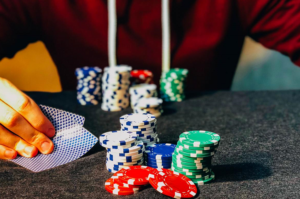Poker, a game of skill, strategy, and psychology, often hinges on the art of bluffing. Mastering the subtle dance of deception and unpredictability can be the key to outsmarting opponents and securing victories. In this comprehensive guide, we’ll delve into the intricacies of poker bluffing, exploring strategies, psychological nuances, and tactical considerations that can elevate your bluffing game.

The Psychology of Bluffing
Bluffing in poker is a psychological chess match. Understanding the mental dynamics at play is crucial. Players often reveal subtle tells or behavioural patterns that can be exploited. Recognizing these cues gives you a strategic edge, allowing you to bluff with precision.
Example: A slight twitch, a fleeting glance—these micro-expressions can betray the strength or vulnerability of an opponent’s hand. The adept bluffer learns to read these cues like an artful detective.
Choosing the Right Moments
Timing is everything in poker bluffing. Picking the opportune moments to execute a bluff is a delicate balance. It involves assessing the overall game dynamics, opponents’ playing styles, and the community cards on the table. A well-timed bluff can turn the tide in your favour.
Example: Bluffing on the river, when the community cards are revealed, can be a high-stakes move. It capitalizes on the uncertainty of opponents who may be hesitant to call without a strong hand.
Understanding Table Image
Crafting a specific table image is a strategic move that impacts the success of your bluffs. If opponents perceive you as a tight, conservative player, a sudden, bold move may catch them off guard. Conversely, if you’ve been bluffing frequently, your opponents may become more sceptical.
Example: Establishing a tight image by consistently playing strong hands sets the stage for a well-timed bluff to catch opponents off guard, leveraging their preconceived notions.
The Semi-Bluff Maneuver
A semi-bluff involves betting or raising with a drawing hand, such as a flush or straight draw. This strategic move serves a dual purpose: it builds the pot if successful, and even if called, you have potential outs to improve your hand.
Example: Betting on a flush draw not only applies pressure on opponents but also provides a backup plan – hitting the flush on the next card can turn a semi-bluff into a formidable hand.
Adapting to Opponents
Effective bluffing requires adaptability. Observing opponents’ reactions and adjusting your approach accordingly is a hallmark of a skilled bluffer. Some opponents may be more susceptible to bluffs, while others may call more cautiously.
Example: If a player consistently folds to aggression, bluffing becomes a potent tool against them. Against a more observant opponent, varying your bluffing frequency keeps them guessing.
Reading Board Texture
The texture of the community cards on the board significantly influences the feasibility of a successful bluff. Understanding how the cards interact and potentially complete hands informs your decision to bluff. A coordinated board may demand a more cautious approach.
The Art of Overbetting
Strategically overbetting the pot can be a powerful bluffing tactic. It sends a bold message to opponents, signalling strength. However, overusing this tactic diminishes its effectiveness, requiring a judicious approach.
Maintaining a Balanced Strategy
The key to effective bluffing is balance. A predictable player becomes exploitable. Incorporating a mix of bluffs and value bets keeps opponents uncertain, making it challenging for them to decipher your intentions.
In Conclusion
Poker bluffing is an intricate dance, requiring a blend of psychology, timing, and adaptability. By mastering the art of deception, players can tip the scales in their favour. Whether executing a well-timed semi-bluff or strategically overbetting, the effective bluffer navigates the poker table with finesse, turning uncertainty into a winning strategy

